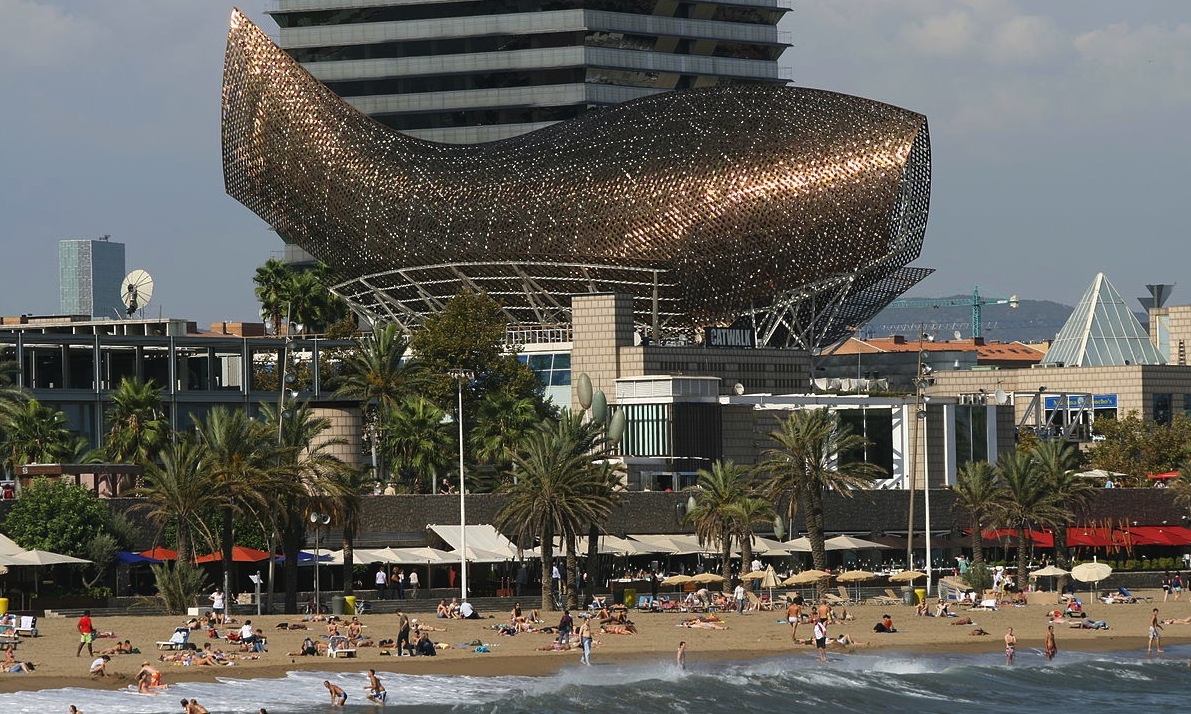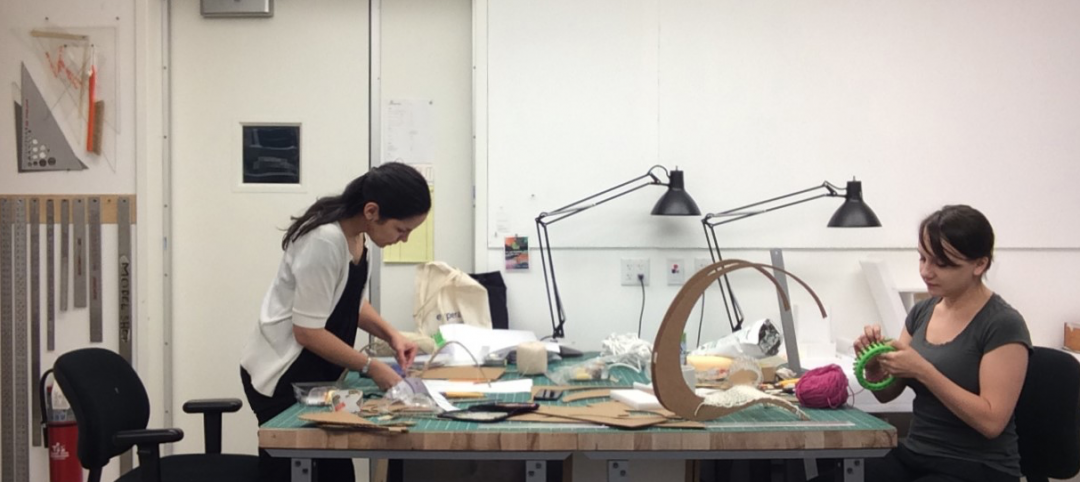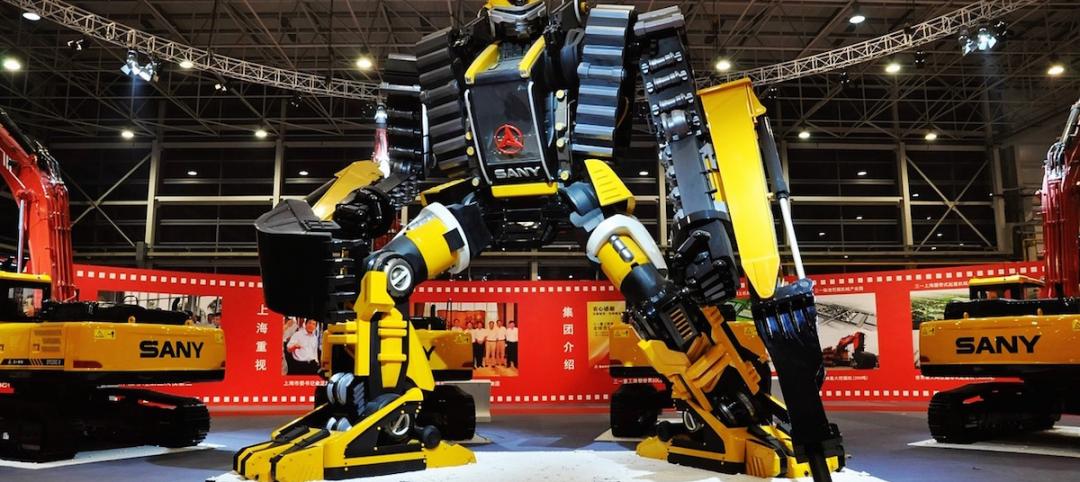In 1977, when engineers with French aircraft maker Dassault Aviation developed a revolutionary 3D CAD tool for its Mirage fighter jet project, architectural design surely was the last application on their minds. Fifteen years later, along came a couple of frustrated architects who were attempting to build a giant golden fish.
The software tool was CATIA. The fish: the shimmering El Peix sculpture on Barcelona’s waterfront, designed as an Olympic Village pavilion for the 1992 games. The architects? I’m sure you guessed by now: Frank Gehry and his long-time tech maestro (and later, Founder of Gehry Technologies), Jim Glymph, FAIA.
Using the industrial design tool, Gehry and Glymph were able to execute the sinuous design scheme, with its curved metal skin and hundreds of unique connections to the internal steel structure, in a matter of months. Moreover, the architectural design team was able to communicate the structure’s complex design to the structural engineer and contractor, so that the components could be fabricated to precise specifications. The entire project, from documentation to erection, was executed in just six months.
For a special report for the January 2016 issue of BD+C, “Game-changers: 7 Projects That Rewrite the Rules of Design+Construction,” the editors are looking for projects—recently completed or in the works—that break the mold of traditional design and construction. To submit your project for consideration, email a project summary and images/renderings to dbarista@sgcmail.com by November 2.
The duo would later implement their newly discovered tool on two of Gehry’s most noted projects: the Guggenheim Museum Bilbao, in Spain, and the Disney Concert Hall, in Los Angeles. The Gehry–CATIA story was born, and parametric modeling began to take hold in the U.S.
Each year, there are a handful of projects like Gehry’s El Peix sculpture that significantly advance the AEC industry or a particular building type. In the green building world, the Chesapeake Bay Foundation’s Philip Merrill Environmental Center in Annapolis, Md. (the first LEED Platinum building), and Oberlin (Ohio) College’s Adam Joseph Lewis Center for Environmental Studies, with its Living Machine wastewater treatment and reuse system, come to mind.
In high-rise design, we look to Rem Koolhaas’s 3D-cranked-loop scheme for the China Central Television (CCTV) headquarters in Beijing, Santiago Calatrava’s Turning Torso in Malmö, Sweden, and the mind-boggling-tall Burj Khalifa, by Adrian Smith (in his SOM days).
In prefabrication construction, projects like Skanska and NBBJ’s Miami Valley Hospital Heart and Orthopedic tower in Dayton, Ohio (one of the first healthcare projects to implement MEP multi-trade racks), paved the way.
Then there’s the High Line, in Manhattan, by Field Operations and Diller Scofidio + Renfro. The elevated-rail-line-turned-park has been such a resounding success that cities across the globe are racing to emulate its linear park template.
I can go on and on naming landmark projects, but I’d rather turn things over to you. For a special report for the January 2016 issue of BD+C, “Game-changers: 7 Projects That Rewrite the Rules of Design+Construction,” the editors are looking for projects—recently completed or in the works—that break the mold of traditional design and construction. Maybe they involve the implementation of advanced tools or methods, the use of clever project financing mechanisms, or the installation of a first-of-its-kind HVAC scheme or novel material. These are just a few ideas to get your creative juices flowing.
To submit your project for consideration, email a project summary and images/renderings to dbarista@sgcmail.com by November 2. We look forward to telling the next Gehry–CATIA story!
More from Author
David Barista | Aug 15, 2019
3 ‘Giant’ AEC market trends for 2019-2020
We’re starting to see a shift toward custom research, thanks in part to the influx of data, data tools, and analytics expertise in the AEC market.
David Barista | Jul 31, 2019
Amenities war no more? Research report explores multifamily market
Multifamily developers show no signs of pulling back on specialty spaces and unique offerings in an effort to attract high-quality tenants, according to new research from Multifamily Design+Construction.
David Barista | Dec 30, 2016
An open letter to the AEC C-suite
Women AEC professionals need you to take action.
David Barista | Sep 6, 2016
Innovation intervention: How AEC firms are driving growth through R&D programs
AEC firms are taking a page from the tech industry, by infusing a deep commitment to innovation and disruption into their cultural DNA.
David Barista | Jun 27, 2016
If ‘only the paranoid survive,’ what does it take to thrive?
“Sooner or later, something fundamental in your business world will change.” The late Andrew Grove (1936-2016), Co-founder of tech giant Intel Corp., lived by these words.
David Barista | May 31, 2016
As commercial buildings get ‘smarter,’ concerns rise over cybercrime
As buildings become increasingly connected, opportunistic hackers have countless avenues into a building’s network.
David Barista | May 9, 2016
Is the nation’s grand tech boom really an innovation funk?
Despite popular belief, the country is not in a great age of technological and digital innovation, at least when compared to the last great innovation era (1870-1970).
David Barista | Mar 31, 2016
Deep Learning + AI: How machines are becoming master problem solvers
Besides revolutionary changes to the world’s workforce, artificial intelligence could have a profound impact on the built environment and the AEC industry.
David Barista | Feb 24, 2016
Is the booming freelance economy a threat to AEC firms?
By shifting the work (and revenue) to freelancers, “platform capitalism” startups have taken considerable market share from traditional businesses.
David Barista | Jan 26, 2016
How the Fourth Industrial Revolution will alter the globe’s workforce
The next great technological metamorphosis will be unlike anything humankind has experienced before, due to the sheer size, speed, and scope of disruption.
















